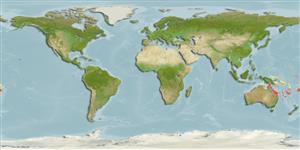>
Kurtiformes (Nurseryfishes, cardinalfishes.) >
Apogonidae (Cardinalfishes) > Apogoninae
Etymology: Taeniamia: Name from feminine Latin noun 'taenia' meaning ribbon or band; and feminine Greek noun 'Amia' meaning a fish, often used with cardinalfishes genera. Here as Taeniamia referring to the vertical wide bars and near vertical to curved narrow bars as lines on most of the species in this genus.
Eponymy: Arthur Mills Lea (1868–1932) was an Australian entomologist with an enduring passion for beetles. [...] (Ref. 128868), visit book page.
More on author: Waite.
Environment: milieu / Zona climática / intervalo de profundidade / distribution range
Ecologia
marinhas associadas(os) a recifes; intervalo de profundidade 1 - 15 m (Ref. 54391). Tropical
Western Pacific: New Caledonia, Norfolk Island and Australia.
Tamanho / Peso / Idade
Maturidade: Lm ? range ? - ? cm
Max length : 9.0 cm TL macho/indeterminado; (Ref. 2334)
Descrição suscinta
Chaves de identificação | Morfologia | Morfometria
Espinhos dorsais (total) : 8; Raios dorsais (total) : 9; Espinhos anais: 2; Raios anais : 12 - 14. Diagnosis: Rays: dorsal VII + I,9; anal II,12-14; pectoral rays 14-15 (rarely 16). Gill rakers 5-7 + 16-19 (total 22-26). Lateral-line scales 25+2-3. Median predorsal scales 4 (rarely 3). Body depth 2.5-2.8 in SL; body width 2.05-2.8 in body depth; eye diameter 2.3-2.8 in head length; first dorsal spine 3.6 or more in length of second spine; second dorsal spine 2.9-4.4, and third dorsal spine 2.1-2.5 in head length; spine of second dorsal fin 2.25-2.8, and second anal spine 2.4-3.2 in head length; pelvic-fin length 4.4-5.0 in SL; caudal-peduncle depth 1.6-2.0in its length, and caudal-peduncle length 4.2-4.6 in SL; distance from insertion of pelvic spine to anal-fin origin 4.1-5.3 in SL. Posterior preopercular edge completely serrate or nearly so; ventral preopercular edge completely serrate; exposed posttemporal edge smooth. Scaly sheath along anal-fin base poorly developed or absent (Ref. 54391).
Body shape (shape guide): fusiform / normal.
Nocturnal species; occurs inshore (Ref. 7300); in shallow coastal and lagoon reefs, in groups among corals (Ref. 9710).
Ciclo de vida ou comportamento de acasalamento
Maturidade | Reprodução | Desova | Ovos | Fecundidade | Larvas
Are mouthbrooders (Ref. 240). Distinct pairing during courtship and spawning (Ref. 205).
Gon, O. and J.E. Randall, 2003. Revision of the Indo-Pacific cardinalfish genus Archamia (Perciformes: Apogonidae), with description of a new species. Indo-Pac. Fish. (35):49 p. (Ref. 54391)
Status na Lista Vermelha da UICN (Ref. 130435: Version 2025-1)
Ameaça para os humanos
Harmless
Uso pelos humanos
Ferramentas
Relatórios especiais
Baixar XML
Fontes da internet
Estimates based on models
Preferred temperature (Ref.
123201): 23.5 - 28, mean 26.3 °C (based on 359 cells).
Índice de diversidade filogenética (Ref.
82804): PD
50 = 0.5001 [Uniqueness, from 0.5 = low to 2.0 = high].
Bayesian length-weight: a=0.01318 (0.00717 - 0.02424), b=3.17 (3.01 - 3.33), in cm total length, based on LWR estimates for this species & (Sub)family-body (Ref.
93245).
Nível Trófico (Ref.
69278): 3.5 ±0.53 se; based on food items.
Resiliência (Ref.
120179): Elevada, tempo mínimo de duplicação da população menor que 15 meses (Preliminary K or Fecundity.).
Fishing Vulnerability (Ref.
59153): Low vulnerability (10 of 100).
🛈
Nutrients (Ref.
124155): Calcium = 162 [97, 314] mg/100g; Iron = 1.12 [0.64, 1.83] mg/100g; Protein = 19 [18, 20] %; Omega3 = 0.157 [0.090, 0.278] g/100g; Selenium = 27.1 [13.4, 52.8] μg/100g; VitaminA = 88.5 [29.9, 262.2] μg/100g; Zinc = 2.25 [1.48, 3.24] mg/100g (wet weight);
